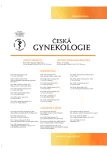Possibilities of objectivization of pelvic floor muscle exercises in patients with urine leakage after delivery
Authors:
M. Hagovská 1; P. Urdzík 2; J. Svihra 3
Authors‘ workplace:
Klinika fyziatrie, balneológie a liečebnej rehabilitácie LF UPJŠ a UNLP, Košice,
prednosta doc. MUDr. P. Takáč, PhD., mim. prof.
1; Gynekologicko-pôrodnícka klinika LF UPJŠ a UNLP, Košice, prednosta doc. MUDr. P. Urdzík, PhD., MPH, mim. prof.
2; Urologická klinika, Jesseniova LF UK a UNM, Martin, prednosta doc. MUDr. J. Ľupták, PhD.
3
Published in:
Ceska Gynekol 2020; 85(2): 94-102
Category:
Overview
Background: Examination of pelvic floor muscle function is very important before starting exercises in patients with urine leakage and other pelvic floor dysfunctions. Perineometer and palpation examination is currently being used. A new trend in physiotherapy is the ultrasound examination of pelvic floor muscles. The examination can be performed by abdominal approach or perineal approach. We evaluate 2D and 3/4D images of pelvic floor muscles.
Methods: The International Consultation on Incontinence Questionnaire Urinary Incontinence Short Form (ICIQ-UI SF). OAB-q – overactive bladder questionnaire - short form. The Urinary Incontinence Quality of Life scale (I-QoL) – self-assessment scale for assessing the quality of life of patients with urinary incontinence. Adjusted Oxford scale to assess pelvic floor muscle strength. PERFECT scheme by Laycock and Jerwood. Pelvic floor examination by perineometer (Peritron-Ontario, L4V, Canada). Pelvic floor examination by 2D and 3/4D ultrasound examination (Volunson-i BT 11 Console, VCI volume contrast imaging software, (GE Healthcare Austria GmbH & Co OG, Zipf, Austria, RAB4-8-RS 3D/4D 4–8 MHz probe). High intensity exercise of pelvic floor muscles with stabilization elements.
Conclusion: The effect of pelvic floor muscle training was objectively proved by the above mentioned objectivization methods with subjective improvement of quality of life. There was also a significant effect of education in USG exercise.
Keywords:
high intensity – pelvic floor exercise – stress urinary incontinence – objectivization
Sources
1. Avery, K., Donovan, J., Peters, TJ., et al. ICIQ: A brief and robust measure for evaluating the symptoms and impact of urinary incontinence. Neurourol Urodyn, 2004, 23, p. 322–330.
2. Abrams, P., Andersson, KE., Apostolidis, A., et al. 17.6th International Consultation on Incontinence. Recom-mendations of the International Scientific Committee: Evaluation and treatment of urinary incontinence, pelvic organ prolapse and faecal incontinence. Neurourol Urodyn, 2018, 37(7), p. 2271–2272.
3. Bo, K., Berghmans, B., Morkved, S., et al. Evidence-based physical therapy for the pelvic floor, 2nd Ed, London: Churchill Livingstone, 2015, p. 446.
4. Bushnell, DM., Martin, ML., Summers, KH., et al. Quality of life of women with urinary incontinence: Cross-cultural performance of 15 la (2005) Language versions of the I-QOL. Qual Life Res, 2005, 14(8), p. 1901–1913.
5. Coyne, KS., Matza, LS., Thompson, CL. The responsiveness of the Overactive Bladder Questionnaire (OAB-q). Qual Life Res, 2005, 14(3), p. 849–855.
6. Cardozo, L., Staskin, D., Currie, B., et al. Validation of a bladder symptom screening tool in women with incontinence due to overactive bladder. Int Urogynecol J. 2014, 25(12), p. 1655–1663.
7. Dietz, HP., Wong, V., Shek, KL. Simplified method for determinating hiatal biometry. Aust NZ J Obstet Gynecol, 2011, 51, p. 540–543.
8. Frawley, H., Galea, M., Phillips, B., Sherburn, M., et.al. Effect of test position on pelvic floor muscle assessment. Int Urogynecol J Pelvic Floor Dysfunct, 2006, 17, p. 365–371.
9. Gágyor, D., Pilka, R., Ondrová, D., Buláková, S. Distal vaginal agenesis. Čes Gynek, 2019, 84(4), p. 283–288.
10. Haylen, BT., de Ridder, D., Freeman, RM., et al. International Urogynecological Association (IUGA)/International Continence Society (ICS) joint report on the terminology for female pelvic floor dysfunction. Int Urogynecol J, 2010, 21(1), p. 5–26.
11. Hundley, AF., Wu, JM., Visco, AG. A comparison of perineometer to brink score for assessment of pelvic floor muscle strength. Am J Obstet Gynecol, 2005, 192, p. 1583–1591.
12. Klovning, A., Avery, K., Sandvik, H., Hunskaar, S. Comparison of two questionnaires for assessing the severity of urinary incontinence: The ICIQ-UI SF versus the incontinence severity index. Neurourol Urodyn, 2009, 28, p. 411–415.
13. Laycock, J., Jerwood, D. Pelvic floor asssessment: the P.E.R.F.E.C.T. scheme. Physiotherapy, 2001, 87(1), p. 631.
14. Kim, EY, Kim, SY, Oh, DW. Pelvic floor muscle exercises utilizing trunk stabilization for treating postpartum urinary incontinence: randomized controlled pilot trial of supervised versus unsupervised training. Clin Rehabil, 2012, 26(2), p. 132–141.
15. Notte, SM., Marshall, TS., Lee, M., Hakimi, Z., et.al. Content validity and test-retest reliability of patient perception of intensity of urgency scale (PPIUS) for overactive bladder. BMC Urol, 2012, 12, p. 26.
16. Rahmani, N., Mohseni-Bandpei, MA. Application of perineometer in the assessment of pelvic floor muscle strength and endurance: A reliability study. J Bod Mov Ther, 2011, 15, p. 209–214.
17. Tosun, OC., Solmaz, U., Ekin, A., Tosun, G., et al. Assessment of the effect of pelvic floor exercises on pelvic floor muscle strength using ultrasonography in patients with urinary incontinence: a prospective randomized controlled trial. J Phys Ther Sci, 2016, 28(2), p. 360–365.
18. Tosun, ÖÇ., Mutlu, EK., Ergenoglu, AM., et al. Does pelvic floor muscle training abolish symptoms of urinary incontinence? A randomized controlled trial. Clin Rehabil, 2015, 29(6), p. 525–537.
19. Tosun, ÖÇ., Mutlu, EK., Tosun, G., et al. Do stages of menopause affect the outcomes of pelvic floor muscle training? Menopause, 2015, 22(2), p. 175–184.
20. Yalcin, I., Bump, RC. Validation of two global impression questionnaires for incontinence. Am J Obstet Gynecol, 2003, 189(1), p. 98–101.
Labels
Paediatric gynaecology Gynaecology and obstetrics Reproduction medicineArticle was published in
Czech Gynaecology

2020 Issue 2
Most read in this issue
- Is the finding of endometrial hyperplasia or corporal polyp an mandatory indication for biopsy?
- Modern terminology and classification of female pelvic organ prolapse
- Laparoscopic correction of isthmocele combined with ventrosuspensios of uterus
- MODY diabetes and screening of gestational diabetes
